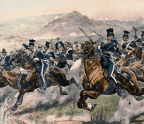‘BOARD HER, BOYS!’


When the American colonies declared their independence from Great Britain in 1776, it set into motion events not considered by the nascent nation’s Founding Fathers. Among the unintended consequences was that in throwing off the British yoke, the United States’ sizeable fleet of unarmed merchant ships also lost the protection of the mighty Royal Navy. And that protection was vital, for by 1780 American ships carrying cotton, tobacco, wheat and rice were generating some $79 million a year in commerce between the New World and Old World.
That lucrative trade was especially vulnerable in the Mediterranean and along the Atlantic coast of North Africa, where pirates sailing from the Barbary states of Tripoli, Algiers, Morocco and Tunis routinely stopped, boarded, seized and/or plundered unarmed merchant ships. The pirates often held valuable cargoes for ransom and imprisoned the captured vessels’ crews or sold them into slavery. There were only two viable means of dealing with the threat posed by the Barbary pirates. The first was armed force, which was logistically complex and costly. The second was the annual payment of massive bribes—diplomatically referred to as “tribute”—arranged by treaty. Even Great Britain, with its globe-spanning navy, was inclined to pay tribute rather than deal with the expense of a protracted naval campaign.
The U.S. merchant fleet’s loss of Royal Navy protection meant the Barbary pirates were free to attack and capture American ships and crews. They wasted little time. Beginning in 1784—the year the allied French navy ceased shepherding U.S. vessels—the pirates began seizing American ships and imprisoning their crews. U.S. ambassador to France Thomas Jefferson soon negotiated a treaty with the Barbary states, pledging an annual tribute of $1 million and securing release of the captive crews.
The arrangement ultimately fell apart, however, forcing Jefferson’s hand.
the pasha of Tripoli, rebuffed in his demand for an additional tribute from newly elected third U.S. President Jefferson, directed his
You’re reading a preview, subscribe to read more.
Start your free 30 days



